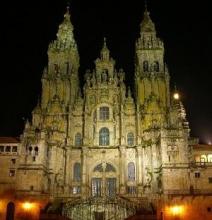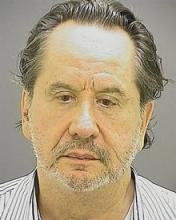The Codex of Calixtinus, a unique illuminated book from the 12th century under the auspices of Pope Calixtinus II from which it gets its name. The book describes the life of St. James the Apostle, whose remains supposedly washed up on the shores of northwestern Spain near the town named for the Saint, Santiago de Compostela (Santiago means "St. James" in Spanish). The Codex, which related the life and times of St. James, turned up missing from a safe in the cathedral of Santiago de Compostela on July 5th. However, clergy did not report the theft publicly until July 11th.
After St. James' remains washed up outside the Spanish village, Santiago de Compostela became the third most important medieval pilgrimage site in the 12th century Christian world; surpassed by only Jerusalem and Rome. For over a century Christian pilgrims would journey from all over the continent to see St. James and the Codex, and to worship at its holy sites. For the reason, the Codex Calixtinus is actually one of the most important books (codex really just means 'book') of the Medieval period. It describes not only St. James, but gives instructions on how to reach the holy sites around Santiago de Compostela, poisonous rivers to avoid, even areas of Basque control to avoid and unscrupulous French ferrymen that overload boats in order to steal their drowned passengers belongings.
Unscrupulous seems to be a fitting word for the theft of the Codex, which was removed from the safe without force; the keys left swinging in the safe door. The ornate Spanish cathedral (pictured above) did not practice tight security, preferring as many churches do, to rely on good faith and the honor system. However, access to the Codex was strictly controlled, with only two priests ever able to remove the book from the safe. Both priests are resolved of wrong-doing but investigators say that this points to the fact that it was most likely an 'inside job'. Richard Oram, a rare-book collector and director of the University of Texas at Austin's Harry Ransom Center, the largest collection of rare books in the U.S., says, "Any expert, or even someone with basic knowledge, would be able to instantly identify [the Codex] and know that it was stolen...it would be impossible to sell." He went on to relate his own experience with library theft, in which a volunteer stole 300 volumes from the Ransom Center. ""The general rule of thumb is that 60% or 70% of library thefts are by patrons, but the dollar value of the thefts tilts disproportionately toward employees."
This is the second high-profile historical artifact theft in as many weeks as the Maryland Historical Society attempts to get its affairs in order after a renowned Presidential historian and his accomplice stole over 60 documents, including some signed by Abraham Lincoln, potentially worth millions of dollars. Barry Landau has one of the largest collections of Presidential memorabilia outside of the Presidential libraries, but with his latest heist revealed, he may be audited on the rest of his collection for origin of procurement, value, and authenticity.

